|
December 2009 - March 2010 |
| |
|
|
 |
|
 |
| |
Publisher:
Chairman Sheng-Lung Huang Editors:
Prof. Jui-che Tsai, Ms. Hsiao-wen Lin April 15,
2010 |
| |
|
 |
|
Congratulations! GIPO Professors Powen
Hsu and Ching-Fuh Lin receive the title
of “2010 IEEE Fellow”.
Congratulations! GIPO
Professor Ching-Fuh Lin receives the
title of “2010 SPIE Fellow”.
Congratulations! GIPO Professor Gong-Ru Lin
receives the title of “2010 IET Fellow”.
|
|
 |
|
 |
|
| |
|
 |
|
November
“Photonics Forum”
Lecture Highlights |
|
|
November 6th, 2009
(Friday), 2:30 PM |
|
Speaker: |
Prof. Milton
Feng
(the Nick Holonyak Jr. Chair
Professor of Electrical and Computer
Engineering, the University of
Illinois at Urbana-Champaign) |
|
Topic: |
Transistor Lasers -
The Magic Devices for Electronic and
Photonic ICs |
| |
Professor Milton Feng visited GIPO
on November 6th,
2009 (Friday) and lectured in
Auditorium 101, Barry Lam Hall. The
topic, “Transistor Lasers – The
Magic Devices for Electronic and
Photonic ICs” elicited enthusiastic
attendance and participation from
GIPO professors and students, and
everyone learned much. |
|
 |
|
Vice Chairman Gong-Ru
Lin, emcee of the event (left), with
Professor Milton Feng (right) |
|
December
“Photonics Forum”
Lecture Highlights |
|
|
December 11th, 2009
(Friday), 2:30 PM |
|
Speaker: |
Prof. Jye-Hong
Chen
(Department of Photonics, National
Chiao Tung University) |
|
Topic: |
The Law of
Accelerating Returns: its
implications? |
| |
Professor Jye-Hong Chen visited GIPO
on December 11th, 2009
(Friday). He lectured in Auditorium
101 on the topic of “The Law of
Accelerating Returns: its
implications?”, and GIPO professors
and students attended the lecture
with enthusiasm. Everyone learned
much from the event. |
|
 |
|
Speaker, Professor Jye-Hong
Chen |
|
|
December
18th, 2009 (Friday), 2:30~3:30 PM |
|
Speaker: |
Prof. Guang-Xu
Cheng
(Department of Physics, Nanjing
University) |
|
Topic: |
A Discussion of Raman
and Brillouin scatterings |
| |
Professor Guang-Xu Cheng visited
GIPO on December 18th,
2009 (Friday) to speak on the topic
of "A Discussion of Raman and
Brillouin scatterings". GIPO
professors and students attended the
event with enthusiasm. Professor
Cheng’s lecture was interesting and
thorough, and he interacted with his
audience throughout the lecture.
|
|
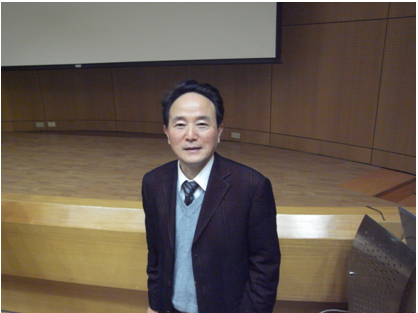 |
|
Speaker, Professor
Guang-Xu Cheng |
|
|
December
18th, 2009 (Friday), 3:30~4:30 PM |
|
Speaker: |
Prof. Bing-Bing
Liu
(Associate Director, State Key
Laboratory of Superhard Materials,
Jilin University ) |
|
Topic: |
Structure of C60
Confined in Single Walled Carbon Nanotubes Studied by NIR Raman
Spectroscopy under High Pressure |
| |
Professor Bing-Bing Liu
visited GIPO on December 18th,
2009 (Friday) to speak on the topic
of “Structure of C60 Confined
in Single Walled Carbon Nanotubes
Studied by NIR Raman Spectroscopy
under High Pressure”. GIPO
professors and students attended the
lecture with enthusiasm. Professor
Liu’s lecture was fascinating and
exciting, and she interacted with
her audience throughout the lecture.
Those who attended learned much. |
|
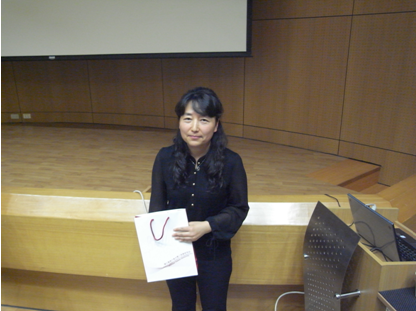 |
|
Speaker, Professor
Bing-Bing Liu |
~ Series
Report of the 1st Microstructure
Photography Contest 2009 ~
(Date of
judging: August 17th, 2009; location:
B1, Barry Art Gallery, Barry Lam Hall, NTU)
|
《Good》
【Title】Sword Casting
【Photographer】Han-Min
Wu |
|
 |
|
《Good》
【Title】A
Small Great World
【Photographer】Chiao-Ying
Lin |
|
 |
|
《Good》
【Title】Fireworks
Day
【Photographer】Ming-Wei
Chen, Chin-An Lin |
|
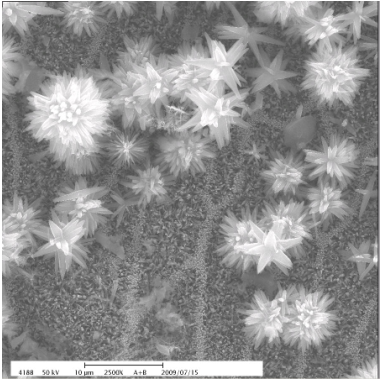 |
|
《Best
Photography Technique》
【Title】Breaking
the Boundary
【Photographer】Chan-Chia
Tseng, Cheng-Ming Lin |
|
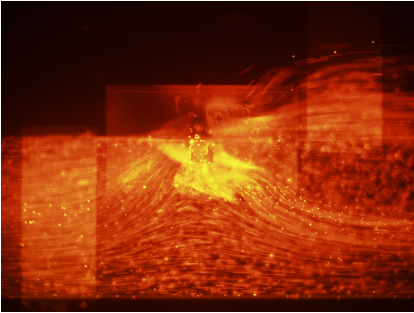 |
|
《Best
Photography Technique》
【Title】When
the Cherry Tree Blossoms
【Photographer】Cheng-Ying
Chen, Yen-Chun Chao |
|
 |
|
《Best
Photography Technique》
【Title】Blind
Deference
【Photographer】Ming-Rung
Tsai |
|
 |
|
《Best
Creativity》
【Title】A
Great Thunderclap
【Photographer】Yen-Chun
Chao, Cheng-Ying Chen, Yi-Ruei Lin,
Yu-An Dai |
|
 |
|
 |
|
 |
|
| |
|
 |
~ The Second International Conference on
White LEDs
and Solid State Lighting
(White LEDs 2009) ~
(Time:
December 13th ~ 16th, 2009; Location: Taipei International Convention
Center)
Composed by: Wen-Ping Chen
The
Second International Conference on White LEDs and Solid State Lighting
(White LEDs 2009), held by GIPO's Professor C. C. Yang, took place on
December 13th~16th, 2009, at Taipei
International Convention Center. The conference lasted for two and half
days, showcasing 156 published papers, including 3 of the keynote
speeches, 20 of the invited talks, 7 of the industrial forums, 41 of
oral presentations (contributed papers) and 85 of poster presentations
(contributed papers). The event attracted 330 specialists from 15
countries/regions, including Austria, Mainland China, Germany, Hong
Kong, India, Israel, Japan, Korea, Lithuania, Malaysia, Holland, Russia,
Taiwan, United Kingdom, and USA. The conference featured eight major
topics, including “Semiconductor epitaxial growth and characterization
for LED fabrication,” “Organic/polymer and phosphor material preparation
for OLED/LED fabrication,” “Semiconductor LED design and fabrication,”
“Organic/polymer light-emitting device design and fabrication,” “Nanotechnology for enhancing emission efficiency,” “Packaging and
system,” “Various applications,” and “Other LED topics.”
The conference events were plentiful and diverse. There were 3
keynote speeches on the morning of the first day (Dec. 14th).
The invited speakers were Professor Fred Schubert of Rensselaer
Polytechic Institute (USA), Professor James Speck of University of
California at Santa Barbara (USA), and Professor Katsumi Kishino of
Sophia University (Japan). In the afternoon, there were 2 oral sessions
- Epitaxial growth (I) and Packaging, followed by the poster session.
The conference reception took place in the evening of the first day.
During the morning of the second day, 4 sessions took place - OLED and
phosphor (I), LED device (I), OLED and phosphor (II), and LED device
(II). In that afternoon, there were 2 sessions - Applications (I) and
Applications (II), and an industrial forum, where 7 industrial
specialists were invited to lecture and held a panel discussion. A
conference banquet ended the day. During the morning of the third day,
(Dec. 16th), there were 4 sessions discussing epitaxial
growth and LED device. In consideration of the fact that many of the
conference participants were visiting from other countries, special
arrangements were made so that these participants had a chance to visit
the National Palace Museum on the afternoon of the third day. This short
trip hopefully provided participants with more opportunities for
face-to-face interaction and cultural exchange.
The conference took place in
mid-December while the weather in Taipei was cool and comfortable; in
addition there were no other international conferences taking place at
that period of time. Thus, there were a large number of foreign
specialists participating in this conference. Furthermore, the hardware
facilities of the conference site, Taipei International Convention
Center, were excellent, and the surrounding environment as well. These
advantages served to greatly elevate our country's international
reputation. During the reception and the banquet, the Lan Yang Dancers
and the Han-Tang Yuefu Ensemble were invited to perform, and students of
National Taiwan University of Arts were also invited to perform
traditional Chinese music. Their performances received tons of praise.
In order to give due attention to both
theory and practical application, we arranged the industrial forum and
invited industrial specialists from Malaysia, USA, Taiwan, Mainland
China, Germany, Japan and Korea to publish papers and participate in
discussions. They interacted closely with the conference participants
and thoroughly answered questions. The industrial forum was truly a rare
opportunity for the industry and academia to exchange information and
share knowledge.
Taiwan is not only the world’s
leading producer of LED, but also one of the front-runners in
LED-related research. This is the second time the conference has been
held in Taipei, and its meaning is significant. There were 330
specialists taking part in the event, including those from the local
academia, industry, and research institutes, and those from many other
countries. This is a great occasion for Taiwan's photonics industry and
academia, and will greatly influence the development in Taiwan's related
research and industry.
|
Sign-in desk |
Keynote speech |
|
Conference
session |
Poster session |
|
Panel
Discussion (Industrial Forum) |
Conference
banquet |
|
Conference
banquet |
Invited
speakers with the Han-Tang Yuefu
Ensemble |
~ Asian Conference on Ultrafast Phenomena
~
(Time: January 10th
~ 13th, 2010; Location:
Barry Lam Hall, NTU)
Composed by: Chia-Hsun
Chiao
Professor Chi-Kuang Sun of GIPO held the 6th
Asian Conference on Ultrafast Phenomena on January 10th~13th,
at the beginning of the new year. 150 scholars from 10 countries
registered and participated in this conference. The conference was also
open for students and teachers of GIPO, Department of Electrical
Engineering, Department of Physics, Chemistry Department, etc. to attend
without charge. We believe that with this conference, through the
exchanges and interaction among many countries' scholars, we will be
able to achieve the purpose of promoting the research of ultrafast
phenomena, integrating Taiwan's ultrafast phenomena research projects,
and promoting international research collaboration. Thus, higher
education in Taiwan can also be elevated accordingly.
The Asian Conference on Ultrafast
Phenomena is held every other year. It began in 1999 in Korea, then
subsequently in Japan, Mainland China, Hong Kong, and Singapore. GIPO's
Professor Chi-Kuang Sun chaired this 6th conference. Aside
from scholars from the above-mentioned countries, there were also
scholars from USA, Russia, Canada, and India this time. Topics that were
discussed covered the study of ultrafast phenomena in optics, physics,
chemistry, and biology. In addition to providing opportunities for all
scholars to share the newest research results, the conference also
provided an opportunity for foreign scholars to learn of Taiwan's
research accomplishments, and was, therefore, an important event for
promoting international collaboration.
The 6th conference began on
January 10th and ended on January 13, lasting 4 days. The
opening ceremony took place with Professor Chi-Kuang Sun as the host. In
total, 35 world famous scholars were invited to give talks and 90
research papers from all over the world were submitted for the
conference. Professor Sun addressed participants by saying the
following: Asia’s great progress during the last decades is not only
obvious to all, but has also allowed Asian countries to become a major
force in the technological development of the world. Femtosecond
technology is now one of the most advanced areas of science. It not only
links closely with ultrafast phenomena study, but also deeply influences
research in the areas of clinical medicine, environment and energy,
high-speed communication, nano-fibers, and national security. Countries
in Asia could possibly lead the world in science and create new
milestones if they could increase exchange and collaboration in
ultrafast phenomena research.
In addition to the invited talks, we
also arranged oral and poster presentations for the contributed papers.
This was done to allow conference participants opportunities to discuss
particular subjects on-site during the four days of the conference. The
conference also featured a contest for the Best Paper Award, sponsored
by Coherent/SuperbIN. Graduate students and postdoctoral researchers who
had submitted papers made oral presentations and competed for the Best
Paper Award. NTU's Chien-Sheng Liao of the Department of Physics stood
out above the rest and became one of the five winners.
Aside from discussion of research,
this conference was also held with the goal of increasing
internationalization of NTU. Professor Sun introduced NTU's history, its
academic status in Taiwan, and its current research projects of
international collaboration. During the conference, a Russian scholar
proposed a joint project, expressing a wish to promote academic
collaboration between our two countries. Professor Sun also made
arrangements for conference participants to visit the National Palace
Museum, and introduced National Chiang Kai-Shek Memorial Hall, the Grand
Hotel, and the Taipei 101, all of which are famous landmarks in Taipei.
We hope to introduce to our world scholars Chinese culture, and some of
its historical relics. Hopefully, our conference participants also
experienced the colorful features of Taipei city.
The 6th Asian Conference on
Ultrafast Phenomena has been brought to a successful close. It has not
only achieved the original goal of integrating Taiwan's ultrafast
phenomena research efforts and promoting international research
collaboration, but has also allowed our staff to gain valuable
experiences in handling international conferences. With these
experiences, we will do even better hosting other international
conferences in the future. GIPO will continue to support NTU's
professors and students and Taiwan's academia in participating in more
international conferences, so as to promote international research
collaboration, and to improve our country’s higher education.
~ A memoir about the visit of 3 EU
countries' 5 universities, concerning Erasmus Mundus MSc in
Photonics ~
(Time:
March
1st ~ 5th, 2010;
Visit:
Belgium, Sweden, UK)
Composed by:
Prof. Sheng-Lung Huang (Chairman of GIPO, NTU)
The Erasmus
Mundus programme of the European Union aims to integrate EU’s higher
education and to improve its quality. There are over a hundred master
programmes, in different fields, under EU's Eramus Mundus programme. In
addition to improving the quality of higher education in EU countries,
this programme also seeks to cooperate with top universities of
non-member countries. The first stage began in 2004 and ended in 2008,
spending 230 million Euros. The second stage began in 2009, and will end
in 2013, with its budget amounting to 950 million Euros. During this
second stage, EU is also, for the first time, accepting non-member
country's universities as full partners in conferring joint or double
degrees.
There are 5
universities from 3 countries taking part in Erasmus Mundus MSc in
Photonics (EMMP) programme, coordinated by Ghent University (Belgium)
and has four other consortium partners: Vrije Universiteit Brussel
(Belgium), University of St Andrews (UK), Heriot-Watt University (UK),
and Royal Institute of Technology (Sweden). In early 2009, while on
sabbatical and studying in Ghent University, NTU professor Ruey-Beei Wu
thought of the possibility of a cooperative project between UGent and
NTU. Therefore, he enthusiastically contacted Prof. Roel Baets, the
coordinator of EMMP, and myself. Professor Roel Baets then, after
learning of NTU's solid strength in photonics, invited me to participate
in their EMMP summer school, a programme in which master students from 5
universities attend together at UGent in June 2009. Through
participation in this event and through meetings with coordinating
professors of the 5 universities, I have come to understand that EU
universities are conscientious and pluralistic about education, and have
designed their courses to address the needs of students' learning. I
then realized that there is indeed a lot we can learn from them. I,
therefore, invited Prof. Roel Baets to visit NTU when he had the chance
to travel to Asia last August. He was received by Dr. Tung Shen, Dean of
the Office of International Affairs, NTU, personally. Dr. Tung Shen
actively promoted NTU’s participation in the second stage of the EM
programme. The joint course programme and double degree partnership have
been strongly supported by the former dean Soo-Chang Pei and the
incumbent dean Lin-Shan Lee of the College of Electrical Engineering and
Computer Science. All this has helped create EU universities and NTU's
double master degree programme.
After
having interacted with EU's education system, I have realized that
Taiwan's Americanized education system is very different from EU's. This
EM project is very much characterized by students' mobility in learning.
Under the circumstances, in order to create substantial cooperation,
EU's education concept has to be integrated with NTU's master degree
norms, and each partner university's course guidelines and academic
rules have to be further discussed. Moreover, EU's master degree
emphasizes the importance of having diverse courses, including: the
core, the advanced, the multidisciplinary, and the transferable skills
courses; however, NTU focuses on specialized courses and the degree
thesis. Each has its merits, and yet each could also learn from the
other. Master students are important human resources of academic study,
in Taiwan especially; therefore, participating in the EM project could
elevate students' global perspective and, via joint thesis from both EU
universities and NTU, could also promote academic cooperation amongst
countries. Thus, in order to further understand relevant operation
procedures and to further assess the possibility of cooperation of study
fields, it is necessary for EU universities and NTU's professors and
administrators to communicate further. For these reasons, in late 2009,
in a briefing to EECS to strive for NTU's "Top University Plan" funds, I
brought up the idea of visiting the 3 EU countries' 5 universities. This
idea was strongly supported by EECS and received with enthusiasm by GIPO
colleagues. Therefore, a visiting delegation of seven, including Vice
Chairman Gong-Ru Lin, Professor Ching-Fuh Lin, Professor Hoang-Yan Lin,
Professor Chih-I Wu, Professor Snow H. Tseng, Ms. Hsiao-wen Lin - the
administrator of international affairs of GIPO, and myself, was formed,
and the visit was scheduled for early 2010.
After
having heard my idea, Prof. Baets and other universities' coordinating
professors responded with enthusiasm. Each school prepared for our
visit, arranging small workshops, arranging meetings with high-level
school staff, allowing us to visit important laboratories, setting up
interviews with EM programme students, etc. Unfortunately, due to the
fact that our professors still had duties in NTU, we could spend only a
week visiting Europe. However, we were loath to miss any of the 5
universities. Finally, an extremely tight schedule was reached, we would
have to visit one university a day, starting from Monday and ending on
Friday. Prior to the visit, we held 3 meetings within GIPO in order to
divide work amongst colleagues and to plan out our itinerary. For each
of the 5 universities, one of us was made responsible for a thorough
understanding of it. Professor Ching-Fuh Lin also promised to ask his
father-in-law, Mr. Tseng-Hwei Lin, a famous calligrapher, to create a
work of calligraphy as a souvenir for each university.
Our
European tour of 5 universities in 5 days gave us a feeling of toiling
night and day. I recall when we arrived at Sweden, it was snowing while
the plane landed in Stockholm at 9:30 pm. When we were assigned to hotel
rooms, it was sometime past 11 pm, and we had to face the awkward
situation of cleaning without any soap, because of an environmental
friendly policy. To make things worse, early next morning, we had to
walk in the snow to the location of the workshop before it started at 9
am. After such a busy day, we then had to get up at 4 am on the morning
of the third day to pack our luggage in time to take the 7 am plane from
Stockholm to Edinburgh, UK. These situations were typical of the
jam-packed trip. Nevertheless, when we were warmly received by each
university, when our colleagues were engrossed in animated discussions
with our hosts, and when our EM project became clearer and clearer, I
was convinced that all our toil would be worthwhile. We will publish
other professors' articles concerning this visit and the EM project in
subsequent GIPO Newsletters.
|
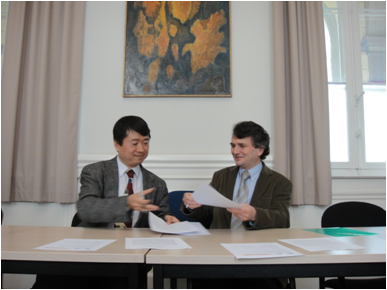 |
|
Figure 1:
Exchanging partnership agreements,
signed by Si-Chen
Lee, President of NTU, and Paul Van
Cauwenberge, President of UGent, with
Prof. Roel Baets. |
Three things about this visit
made a deep impression on me, and I believe
I have gained much from them. The first is
the Photonics Knowledge Tree, designed by
the 5 universities. Since the EM project
stresses that students have to study in at
least 2 EU countries, it becomes important
to know how to avoid repeating the same
topic or omitting any important photonics
fundamental topic. They recently sorted out
these core photonics topics and the time
needed to study them, which is very helpful
to students in choosing their courses. With
this information, students can learn
comprehensive photonics subjects more
efficiently. The second thing is that they
place much importance on fundamental
photonics experiments during master years. I
was especially impressed, and a bit put to
shame, by Prof. Ajar Kar's 40 photonics
experiments, which were splendidly displayed
in his magnificent laboratory in Heriot-Watt
University. I now believe that we should
place more importance on expanding our
fundamental photonics laboratories, both in
undergraduate and graduate schools, even
though its consumables are very expensive.
The third is that, after visiting their
laboratories, I now believe there are lots
of opportunities for us to cooperate.
Through guiding students’ research together,
each side could offset the weakness of its
own by drawing on the strength of the other.
And chances are that, by so doing, we can
maximize our opportunities for making
advanced research accomplishments. Some of
our colleagues had already reached future
cooperation agreements with professors from
the 5 universities before the visit reached
its end.
|
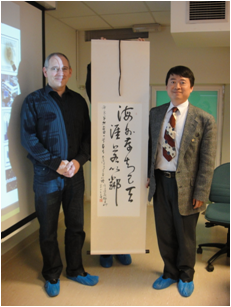 |
|
Figure 2: After his exciting briefing of
the status of Vrije Universiteit Brussel
in photonics research, Prof. Hugo
Thienpont was gifted with a work of
calligraphy. |
|
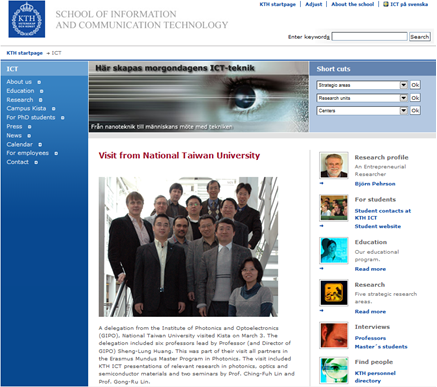 |
|
Figure 3:
GIPO, NTU’s visit was posted on the
website as a top story of School of
Information and Communication
Technology, Royal Institute of
Technology, Sweden. |
|
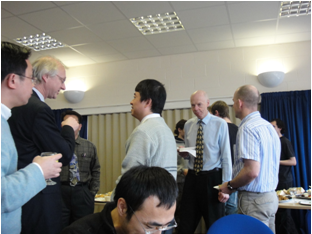 |
|
Figure 4:
Prof. Alan Miller (2nd from the left),
Vice President of Heriot-Watt
University, UK, gave his regards to us
at the reception party. |
|
 |
|
Figure 5:
Having a relaxed informal discussion
with EM students at University of St
Andrews, UK. |
In conclusion, this visit was
the first step towards future cooperation
between NTU and EU partner universities,
because it has laid the groundwork for both
double master degrees and academic
cooperation. It is amazing and admirable
that, after 5-year's integration and
interaction, the 5 EU universities have
evolved from 5 different educational
systems, with different courses and
different tuitions, into a strong, solid,
and pluralistic photonics teaching and
learning environment. It is thus anticipated
that with NTU's participation, the EM
project will create a more colorful double
degree system infused with Taiwanese style.
We believe that with the combination of
Taiwan's abundant photonics production and
research/development capabilities, and EU's
innovative design concepts, we can create a
new, academia and industry compatible style
in photonics.
|
|
|
 |
|
 |
|
| |
|
 |
|
Surface plasmon resonance
in a hexagonal nanostructure formed by
seven core-shell nanocylinders
Professor Ding-Wei
Huang
Graduate Institute of Photonics and
Optoelectronics, National Taiwan
University
We report a hexagonal
structure formed by seven core-shell
nanocylinders filled with different
dielectric cores. Effects from different
illumination wavelengths, dielectric
cores, angles of incidence, were studied
by using the finite-element method.
Simulation results show that the
resonant wavelength is red-shifted as
the dielectric constant increase.
Interestingly, surface plasmon field
which is excited by TM-polarized light
with an incident angle of θ = 15°
is exactly the linear combination of the
fields excited at the incident angles of
θ = 0° and 30°.
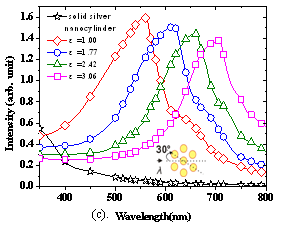 |
Fig. 1.
Near-field intensities versus the
wavelengths of TM-polarized incident
light. Inner radius and outer radius are
20nm and 25nm, respectively. The
calculation point is located at the
central part of the inner nanocylinder
having the maximal near field intensity.
The angles of incidence are (a) θ
= 0°, (b)
θ = 15°, and (c) θ = 30°,
respectively. |
Electromechanical Stability of Flexible
Nanocrystalline Silicon Thin Film
Transistors
Professor
I-Chun Cheng’s group
Graduate Institute of Photonics and
Optoelectronics, National Taiwan
University
We
demonstrated inverted staggered
bottom-gate back-channel-passivated
hydrogenated nanocrystalline silicon (nc-Si:H)
thin film transistors (TFTs) at a
process temperature of 200°C on
colorless polyimide foil substrates.
Because the on-plastic TFTs must keep
functioning during and after mechanical
flexing, we further investigated their
electrical performances and stabilities
under the influence of various
mechanical strain levels. The transfer
and output characteristics were measured
by HP4145B semiconductor parameter
analyzer. The electrical stabilities
were then evaluated by the threshold
voltage shift,
ΔVth,
after applying a gate-bias of 20V with
source and drain grounded for a period
of time. Both the saturation mobility, μsat,
and threshold voltage, Vth,
increased as the bending curvature
increased. The increase of mobility
under tensile strain is plausible due to
the decrease of conduction band tail
width, a similar cause for that observed
in a-Si:H TFTs. The increase of
threshold voltage may due to the
degradation of gate dielectric or the
creation of meta-stable states at the
channel/gate dielectric interface. In
the study of electromehcanical stability
we found that ∆Vth
increased with the stress time and the
amount of ∆Vth
became greater for larger bending
curvature. This indicates that
mechanical tensile strain further
deteriorates the stability of nc-Si:H
TFTs in addition to that caused by
gate-bias stress.
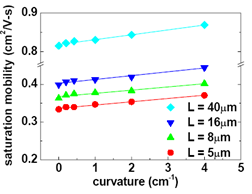 |
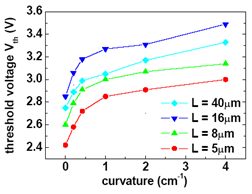 |
|
Fig. 1. (a)
Mobilities and (b) threshold voltages of
nc-Si:H TFTs with various L and fixed
W=5μm under various mechanical bending
levels. |
|
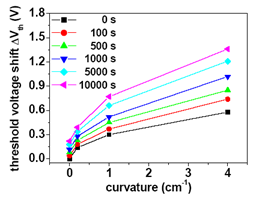 |
|
Fig. 2.
Electrical bias stress-induced threshold
voltage shifts of on-polyimide nc-Si:H
TFTs under various mechanical bending
levels. |
Analysis
of the Optical Phase Conjugation
Phenomenon via PSTD virtual optical
experiments
Professor Snow H.
Tseng
Graduate Institute of Photonics and
Optoelectronics, National Taiwan
University
Experimental research of the optical
phase conjugation (OPC) phenomenon
exhibits interesting phenomena that are
yet to be understood. The OPC refocused
light cross-sectional width is observed
to be approximately the same regardless
of the thickness of the scattering
medium. We employ the
pseudospectral time-domain (PSTD)
technique to accurately simulate the OPC
refocusing phenomenon of light
propagating through a macroscopic
scattering medium. Simulation
results show that the optical thickness
of the scattering medium is not directly
related to the OPC refocused light
width.
|
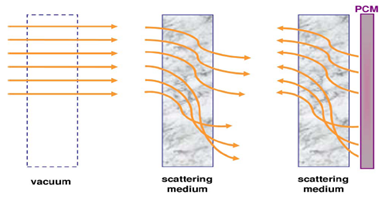 |
|
Fig. 1. After
OPC, multiply scattered light propagates
in reversed directions—similar to a time
reversal process. |
|
Fig. 2.
(left): Amplitude of the OPC refocused
light pulse for various thicknesses of
the scattering medium. Top to
bottom: 40, 80, 120, 160, 200, 240, 280,
and 320
μm,
respectively. (right):
Cross-sectional width of the OPC
refocused light of three different
incident cross-sectional widths plotted
vs. transport mean free path (μs′×L). |
Light
Emission Polarization Properties of
Strained (11-22) Semipolar InGaN Quantum
Well
Professor Yuh-Renn Wu
Graduate Institute of Photonics and
Optoelectronics, National Taiwan
University
We
studied the optical characteristics of a
(11-22) semipolar InGaN/GaN quantum well
with different indium compositions,
quantum well widths, and injection
carrier densities. The self-consistent
Poisson and 6×6 k·p Schrödinger solver
including the effects of quantum
confinement and polarization charges has
been applied to study the band
structures in semipolar InGaN quantum
well light emitting diodes. The
influence of the indium composition,
well width, and injection carrier
density to the (11-22) semipolar quantum
well are studied in this work. The
optical polarization properties are
strongly influenced by the hole
effective mass and the strain effects
especially the shear strain induced in
the semipolar plane. Our studies show
the interesting polarization switching
behavior when the indium composition is
larger than 40%. For the surface
emitting LED, the polarization ratio of
ρyx
′
can be
larger than 0.4 when the indium
composition is smaller than 40%. This
shows a great opportunity of using
semipolar InGaN quantum well LED instead
of c-plane case.
 |
 |
|
Fig. 1. (a)
and (b) are the calculated valence band
dispersion relations of the (11-22)
semipolar InxGa1−xN/GaN
quantum well for x=0.2 and x=0.5,
respectively. |
|
 |
|
Fig. 2. (a)
The relative energy separation of (11-
22) InGaN/GaN quantum well structure and
the strained InGaN alloy film as a
function of indium composition. (b) The
polarization ratios of the InGaN/GaN
(11-22) quantum well as a function of
indium composition. |
ZnO/Al2O3
core–shell nanorod arrays: growth,
structural characterization, and
luminescent properties
Professor J. H. He
Graduate Institute of Photonics and
Optoelectronics, National Taiwan
University
We
demonstrated an aqueous chemical method
to fabricate well-aligned ZnO/Al2O3
nanocrystal (NC) core–shell nanorod
arrays (NRAs). Structural
characterization showed that the shell
layers are composed of α-Al2O3
nanocrystals. Photoluminescence
measurements showed the enhancement of
near-band-edge (NBE) emission of ZnO
NRAs due to the presence of Al2O3
NC shells. The Al2O3
NC shell layer resulting in the
flat-band effect near the ZnO surface
leads to a stronger overlap of the
wavefunctions of electrons and holes in
the ZnO core, further enhancing the NBE
emission. This approach should be very
useful in designing many other
core-shell NRAs for creating varieties
of high-efficiency optoelectronic
devices.
|
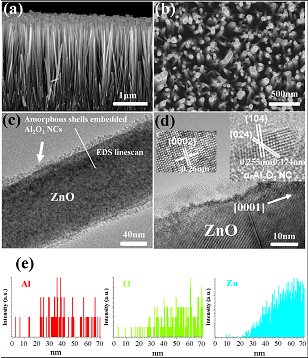 |
|
Fig. 1. (a) A
cross-sectional SEM image, (b) a
top-view SEM image, (c) a TEM image, and
(d) an HRTEM image of ZnO/Al2O3
core–shell NRAs (sample C). The left and
right insets in (d) are the HRTEM images
of the ZnO core and Al2O3
shell, respectively. (e) The linescan of
EDS analysis for ZnO/Al2O3
core–shell NRs in (c). |
|
 |
|
Fig. 2. PL
spectra of the ZnO and ZnO/Al2O3
NC core–shell NRAs at room temperature. |
Modal
Characteristics of Antiresonant
Reflecting Pipe Waveguides for Terahertz
Waveguiding
Professor Hung-chun
Chang
Graduate Institute of Photonics and
Optoelectronics, National Taiwan
University
The
pipe waveguide, which is a thin pipe
consisting of a large air core and a
thin dielectric layer with uniform but
low index, is promising for THz
waveguiding owing to its low-loss
feature and simple structure. In this
research, modal characteristics of the
leaky core modes of the pipe waveguide
are investigated in the THz range.
Utilizing the finite-difference
frequency-domain (FDFD) mode solver,
modal indices and attenuation constants
of the core modes which are frequency
dependent are calculated for different
core diameters, cladding thicknesses,
and cladding refractive indices. It is
found that at certain frequencies no
core modes can exist. Comparing these
frequencies with the resonant
frequencies of the cladding reveals that
the guiding mechanism of the core modes
is that of the antiresonant reflecting
guiding. Calculated results also suggest
that, to have a low-loss and
high-bandwidth pipe waveguide, large
core diameter, thin cladding thickness,
and low refractive index are desired.
The effect of material absorption is
also examined, which shows that the
attenuation constant magnitude will be
increased and the increment is more
significant at higher frequencies.
Moreover, modal patterns are shown for
the fundamental mode and the higher
order modes, including modal intensity
distributions and electric field vector
distributions. It is observed that modal
patterns of the core modes of the pipe
waveguide resemble those of the guided
modes of the step-index fiber. From the
spectrum of the attenuation constant, it
shows that the fundamental mode (HE11-like)
has the smallest attenuation constant
and is the dominant mode for the pipe
waveguide investigated. (Optics
Express, vol. 18, no. 1, pp.
309–322, 5 January 2010.)
|
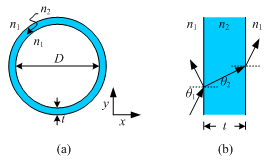 |
|
Fig. 1. (a)
Cross-section of the pipe waveguide,
where n1 = 1
(air). (b) The cladding can be
viewed as a Fabry-Perot etalon. |
|
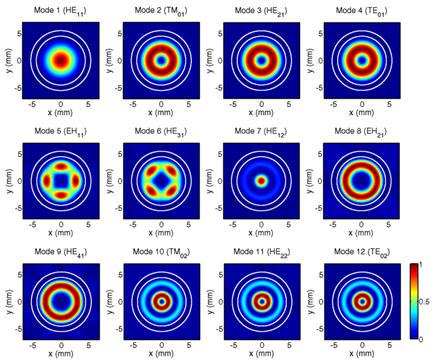 |
|
Fig. 2. Modal
intensity distributions of the first
twelve lowest modes of the pipe
waveguide at 380GHz. The parameters
of the pipe waveguide are: core
diameter
D = 9 mm, cladding thickness
t
= 1 mm, and cladding refractive
index
n2 = 1.4. |
|
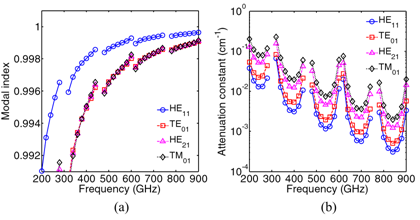 |
|
Fig. 3. (a)
Modal indices and (b) attenuation
constants of the fundamental mode
and the first set of higher order
modes of the pipe waveguide. |
Fabrication of Sphere-like Au
Nanoparticles with Laser Irradiation for
Localized Surface Plasmon Resonance
Applications
Professor
C. C. Yang’s
Laboratory
Graduate Institute of Photonics and
Optoelectronics, National Taiwan
University
We have
demonstrated a simple method for
fabricating substrate adhesive Au
nanoparticles (NPs) of no aggregation
based on a process of laser ablation and
annealing. The size, shape, surface
density, and coverage of Au NPs on a
substrate can be controlled by laser
energy density, substrate material and
surface condition, deposited Au film
thickness, and the liquid covering the
Au film during laser irradiation. With
optical transmission measurements, the
in-plane and out-of-plane localized
surface plasmon resonance (LSPR)
features can be clearly identified due
to the similar shapes and vertical
alignments of NPs on substrate. The
spectral features of substrate-affected
LSPR modes rely on the size,
Au/substrate contact area, substrate
material, and surrounding gas or liquid.
Numerical simulations based on the
finite-element method show highly
consistent results in the LSPR-induced
extinction spectral features. Fig. 1.
and 2. show the plan- and tilted-view
SEM images of Au NPs on a sapphire
substrate. Fig. 3. shows the
transmission spectra of Au NPs on
sapphire and SiO2
demonstrating the LSPR features. For
details, please read the publication: C.
Y. Chen et al., Optics Express 17,
14186 (2009).
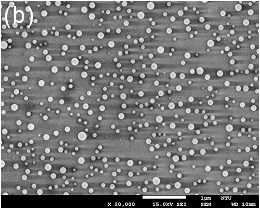 |
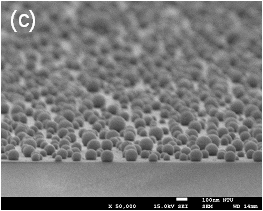 |
|
Fig. 1.
Plan-view SEM image of Au NPs. |
Fig. 2.
Tilted-view SEM image of Au NPs. |
|
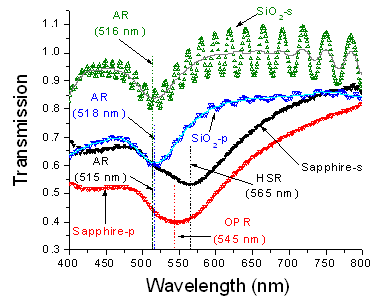 |
|
Fig.
3. Transmission spectra of Au NPs on
sapphire and SiO2
substrates. |
|
|
 |
|
 |
|
| |
|
|
 |
|
 |
|
|
|